#pest control techniques
Explore tagged Tumblr posts
Text
Explore the most effective pest control methods for homes, from eco-friendly solutions to advanced chemical treatments. Learn how to protect your home from common pests like rodents, insects, and termites using safe and efficient techniques. Discover DIY tips and when to seek professional help for long-term pest management.
#effective pest control methods#pest control for homes#eco-friendly pest control#pest management tips#home pest prevention#pest control techniques#professional pest control
0 notes
Text
Why opt Eco-Friendly Pest Control Techniques
The people who are not aware of the advantages of eco-friendly pest control techniques. They can attain complete knowledge like its methods and various benefits because to choose such techniques in our office and home premises. Eco-friendly Pest Control Services in Delhi are basically known as the combined pest management process so as to resolve the problems like enhancement of pests inside or outside your surroundings. These services are helpful as these processes do not have an impact on our environment and most importantly human beings. Therefore, it is advisable to choose such help in Pest Control North Delhi for making your life free from insects and bugs naturally.

Many companies who are working as Pest Control in Noida, try to use an eradicator spraying method. This is not at all appropriate in terms of the environment. Thus, it recommends choosing the services that are working in an appropriate manner so that there will be no harm done to the people and environment. If you are looking for appropriate Pest Control Services in Delhi then make sure that the employees will provide the quality support so that it will not harm the crops and any of the living beings.
What are the advantages of utilizing this eco-friendly Pest Control in North Delhi?
Biodegradable Pest Control – Carbon footprint
One of the major reasons for considering biodegradable pest control is the problem occurring as of carbon footprint. One of the leading reasons for choosing environmental protection and conservation so as to control the enhancement of pests. It is important to understand, that biodegradable products choose to add a small amount of proportion of greenhouse gases. This will be helpful for the environment. Therefore, it provides less influence on carbon print and is meant to be negligible. Thus, there are fewer chances of danger emitting on the atmosphere.
Feasible for the environment
The companies who are working with the processes of biodegradable pest control methods. They try to assist you with a clean food chain in spite of using chemical remedies for settling the food chain. The chemical procedures are not at all appropriate for the environment as well as for human beings. These processes can exterminate pests while they will be destroying the natural food chain.
Easy to preserve the landscape
Another reason is that the biodegradable processes are natural and helpful for the environment. These methods will be feasible in saving our lawn’s regular prestige. Also, they work in an effective manner for removing bugs, rodents, and all kinds of pests from the premises. There will be no negative effects if you are using the chemical-free processes to remove the rodents and spiders.
Complete protection available at home
Do you know that inorganic goods are not appropriate and work as harmful to use in your commercial as well as house area? This problem is more critical when you have kids at your place. As you all know kids are much active and they used to roam in all areas without any limits. If you own the chemical processes then it will be harmful and not protected for your kids.
Choose the effective services of Pest Control in Noida
The people who are looking for effective support and getting rid of the pest problems with the help of eco-friendly manner. Then go with the services that are offering the concepts without using chemical-free methods. Hornets are the best service provider who has trained professionals and provides effective results to all their clients.
#Eco-Friendly Pest Control#Hornet Pest Control#Pest Control Techniques#Pest Control North Delhi#Pest Control in Noida#Pest Control Services in Delhi
1 note
·
View note
Text
How to grow vegetables in 6 simple steps?

Don't know where to start with your own vegetable garden? Check out our new infographic on How to grow vegetables in 6 simple steps! From selecting the right seeds to harvesting your bounty, our easy-to-follow guide will have you growing your own fresh produce in no time.
Visit www.yardener.com for more gardening resources.
Want more gardening resources? Check here
#Vegetable gardening#Gardening tips#Growing vegetables#Step-by-step gardening#Home gardening#Vegetable cultivation#Gardening for beginners#Organic gardening#Planting vegetables#Vegetable garden care#Gardening techniques#Growing your own food#Vegetable gardening guide#Sustainable gardening#Garden planning#Soil preparation#Free Gardening Information#Pest control in gardens#Yardener#Garden maintenance
11 notes
·
View notes
Text
Learn about the health benefits of gardening
#GardeningVibes#Gardening#Horticulture#Landscaping#Plants#Flowers#Vegetables#Garden Design#Organic Gardening#Soil Care#Garden Tools#Watering Techniques#Pest Control#Composting#Pruning#Seasonal Planting
2 notes
·
View notes
Text
Farmers - ರೈತರು ಆಧುನಿಕ ಕೃಷಿ ಪದ್ದತಿಗಳನ್ನು ಅಳವಡಿಸಿಕೊಂಡು, ಅಭಿವೃದ್ದಿ ಹೊಂದಬೇಕು: ನಾಗಮಣಿ
Farmers – ದೇಶದ ಆರ್ಥಿಕತೆಯ ಬೆನ್ನೆಲುಬು ರೈತರು. ಆದರೆ, ಇಂದಿನ ಸ್ಪರ್ಧಾತ್ಮಕ ಜಗತ್ತಿನಲ್ಲಿ ಹಳೆಯ ಕೃಷಿ ಪದ್ಧತಿಗಳಿಗೆ ವಿದಾಯ ಹೇಳಿ, ಹೊಸ ತಂತ್ರಜ್ಞಾನಗಳನ್ನು ಅಳವಡಿಸಿಕೊಳ್ಳುವ ಮೂಲಕ ಆರ್ಥಿಕವಾಗಿ ಸಬಲರಾಗಬೇಕು ಎಂದು ತಾಲ್ಲೂಕು ಪಂಚಾಯಿತಿ ಕಾ��್ಯನಿರ್ವಾಹಕ ಅಧಿಕಾರಿ ನಾಗಮಣಿ ಅವರು ಸಲಹೆ ನೀಡಿದರು. Farmers – ವಿಕಸಿತ ಕೃಷಿ ಸಂಕಲ್ಪ: ರೈತರ ಆದಾಯ ವೃದ್ಧಿಗೆ ಒತ್ತು ಚಿಕ್ಕಬಳ್ಳಾಪುರ ಜಿಲ್ಲೆಯ ಗುಡಿಬಂಡೆ ತಾಲ್ಲೂಕಿನ ವಿವಿಧ ಗ್ರಾಮ ಪಂಚಾಯಿತಿ ಕೇಂದ್ರಗಳಲ್ಲಿ ಚಿಂತಾಮಣಿಯ ಕೃಷಿ…
#agricultural training programs#animal husbandry support#Chikkaballapur agriculture#developed agriculture mission#eco-friendly pest control#farmers income growth#government schemes for farmers#Gudibande farmers#horticulture schemes Karnataka#Karnataka agriculture programs#Krishi Abhiyan Karnataka#modern farming techniques#multiple cropping#organic farming India#soil health
0 notes
Text
A Comprehensive Farming Guide on Tomato Fertilization
Tomato farming in Kenya is one of the most profitable agricultural crops due to the growing demand for tomatoes in both local and international markets. With the country’s population expanding, the consumption of tomatoes, a staple in Kenyan dishes, has increased, making it a viable option for many farmers looking to diversify their farming activities. Kenya’s climate is suitable for tomato…
#agricultural best practices for tomatoes#best fertilizers for tomatoes#biological pest control for tomatoes#blossom-end rot in tomatoes#calcium nitrate for tomatoes#drip irrigation for tomatoes#early blight in tomatoes#fertilization for high tomato yield#Kenya tomato farming tips#late blight in tomatoes#mulching in tomato farming#organic fertilizers for tomatoes#potassium nitrate for tomatoes#soil health for tomatoes#sustainable tomato farming practices#tomato crop rotation#tomato disease prevention#tomato farming in kenya#tomato fertilization guide#tomato fertilization schedule#tomato growth stages#tomato hornworm control#tomato irrigation practices#tomato pest management#tomato pests and diseases#tomato planting tips#tomato post-harvest handling#tomato pruning techniques#tomato variety selection#tomato yield improvement
0 notes
Text
This video highlights how regular tree pruning helps prevent pests and diseases while fostering healthier growth. By removing weak, damaged, or overcrowded branches, trees gain better airflow and sunlight, creating an environment that discourages pests and fungal infections. Learn effective pruning techniques that protect your trees and enhance their vitality for long-term resilience.
0 notes
Text
Enhancing Home Comfort with Strategic Rodent Proofing Measures
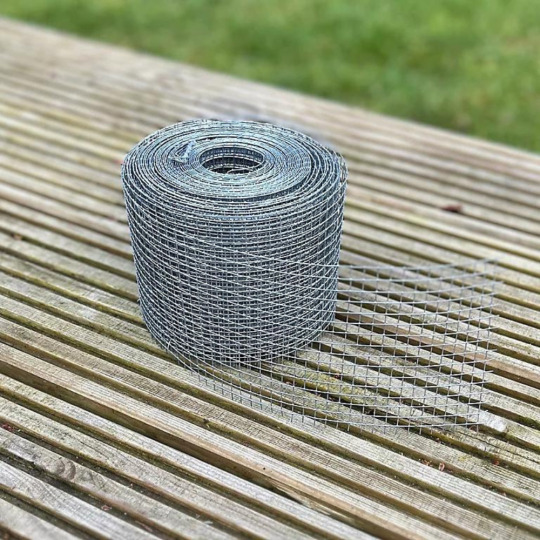
Elevating your home's comfort and security involves more than just regular maintenance; it necessitates a proactive approach to rodent proofing. This essential process not only defends your sanctuary from the intrusion of pests but also significantly improves your insulation's performance. The outcome is a noticeable increase in energy efficiency and a consistently comfortable indoor climate. By adopting cutting-edge strategies and utilizing high-quality materials, our rodent proofing service promises to extend your insulation's lifespan while maintaining a hygienic, safe, and cozy environment. Our experts excel in identifying and sealing off vulnerabilities, providing a robust defense against rodents. Prioritizing rodent proofing is not just an investment in your property's integrity; it's a commitment to the health and comfort of those who call it home. Choose to safeguard, insulate, and elevate your living space with our comprehensive rodent proofing solutions.
YS Attic Insulation Inc 2130 N Arrowhead Ave Unit 205 D San Bernardino, CA 92405, United States (909)488-0763
http://ysatticinsulationinc.com
#Rodent Exclusion Solutions#Pest Barrier Techniques#Home Insulation Protection#Eco Friendly Rodent Control#DIY Rodent ProofingTips#Rodent Prevention Methods#Safe Rodent Repellents#Integrated Pest Management
0 notes
Text
Growing Lemons in Phoenix and Tucson, Arizona
Citrus fruits have long been a staple in the horticultural tapestry of low desert regions, their vibrant hues and invigorating aromas adding a touch of Mediterranean charm to the arid landscapes. Among these sun-soaked oases, the cultivation of lemons emerges as a particularly enticing endeavor. The twin cities of Phoenix and Tucson, cradled by the embrace of the Sonoran Desert, offer an…

View On WordPress
#Citrus Cultivation#Citrus diseases#Culinary creations#Desert landscapes#Fertilization#Frost Protection#Gardening Tips#Gardening wisdom#Harvesting lemons#Homegrown lemons#Horticultural harmony#Lemon trees#Lemon varieties#Low desert gardening#Organic solutions#pest control#phoenix#Pruning techniques#Resilient gardening#Sustainable practices#Tucson
0 notes
Note
Geto with curse reader?
Geto Suguru
TW: implied noncon, held hostage-ish, Geto uses the word monkey
gn reader

You backed up to the very far end of your cage. Holding your knees tucked tight to your chest as you shivered on whimpers and troubled breathing. Your captors, in the dozens, all lay limp on the floor – while the man who’d killed them all made ripples in the bloody pool with his sandals.
You couldn’t see his face. You couldn’t see much more than that below his waist. But you sensed it nonetheless – he wasn’t a normal man. You figured, since you only barely saw him, he wouldn't see you if you stayed silent – but naturally… if you sensed him, it was only a matter of time before he sensed you, too.
“They’re all gone now.” He said, and there wasn’t anyone else there besides you.
Still, you kept quiet. Hoping maybe he was simply talking to himself.
But then he took steps in your direction, making splashes in the blood soiling the floor, until he crouched down next to your cage. He pulled back the curtain hiding you and revealed the blood splatter decorating his smiling face.
“You don’t have to fear anymore, I won't hurt you.”
Humanlike curses aren’t normally all that feral – with exceptions, of course, but you weren’t one. As someone who’s tasted plenty of curses, he could tell your type. You weren’t violent in nature. Unlike most curses, your technique wasn’t defensive but simply protective and could only inspire carnal passion – almost like an aphrodisiac. And like a squid’s ink, it would seem you couldn’t control it either – releasing it like a mist when you were rattled.
The room went thick with it now – but weak a curse as you were, it hadn’t much of an effect on him.
Still, he found you quite cute where you sat, eyes wide, looking at him warily.
“You’re a- a sorcerer. You’ll kill me too. That’s why you’ve come, isn't it?” You whispered – as though you didn’t dare speak any louder.
He could only imagine what they’d done to you, but if your state told him anything… he’d say it wasn’t very humane.
Monkeys are an ugly pest, not just a stain on sorcerers – but curses too, it would seem.
“I came to slaughter the pigs piled on the floor.” He corrected. “They owed me a lot of money, you see. Their fates were sealed the moment I heard they were all broke.”
It didn’t seem to ease your worry. You still looked as though you were waiting for something. Something you dreaded with every inch of your goose-bumped skin.
“Suppose, now that they’re all dead, you’re the only one left to pay their debt.” He chuckled, but you didn’t find it very funny.
Sure, he could twist you into a ball and consume you like he does all the curses he encounters – you’d be a nice addition to his collection, and you didn’t seem like you’d taste any bad either. But still… there are other methods of coveting something – especially when they’re as pretty as you – though perhaps not in a cage.
Either way, you didn’t seem like you’d be much trouble, and besides… he’d been meaning to get a pet to cure the loneliness of coming home to an empty temple.
He smiled, standing up.
You felt your cage lift from the ground, swaying as you were carried above the bloody bodies growing cold with death beneath you.
“Don’t worry, pretty curse. You alone will be payment enough.”
#yandere jjk#yandere jujutsu kaisen#yandere#jujutsu kaisen#gojo#yandere geto#yandere geto suguru#yandere suguru#geto suguru#geto x reader#jjk geto#geto smut#suguru smut#jjk suguru#geto x you#geto x y/n#suguru#jjk imagines#jjk#jjk x reader
1K notes
·
View notes
Text
The Mystery of Blacksteel Sanctum: A Retrospective
So, I loved TDP: Xadia, right? And my no-question favorite region was the Border: best environments, best NPCs, best-ish puzzles (look that ones a close call, okay), and best, most lore-rich story... which, in true TDP fashion, winds up raising more questions than it answers.
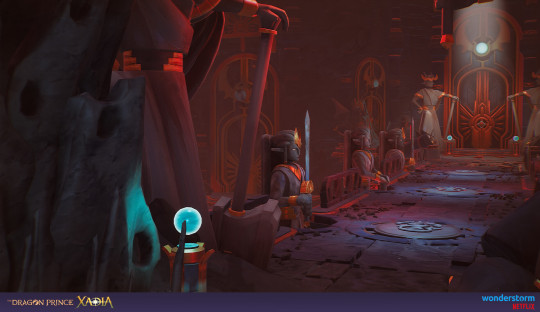
This post, and the thought I've put into it, are kind of my love letter to that story... and the other people who loved it, or could have loved it.
So: let's talk about what was going on in Blacksteel Sanctum.
Catch-Up Summary for Non-Players
If you played TDP: Xadia during its brief lifespan, you can skip this section. But to bring anyone who didn't up to speed:
In the Border region, a joint effort is underway to establish and secure reliable routes for crossing between Xadia and the Human Kingdoms. This is challenged by two fronts of enemies—magma crawlers, an aggressive part-bug and part-crab pest species infesting the area, and Saranar and the Dawnbringers, a faction of rebel Sunfire elves hostile to the new peace. The missions for the region are thereby divided into two "plotlines" directed by accompanying NPCs: the crawler plot, led by human rogue zoologist Mervyn and ending with the Crawler Queen boss, and the Blacksteel Sanctum plot, led by Sunfire elf Knight Ravna and ending with the Blacksteel Forgemaster boss.
Got it? Okay.
Digging for the Truth: Blacksteel Sanctum Basics
After first encountering the (sealed) Blacksteel Sanctum beneath the surface of the Border, Ravna expresses shock that not only is the Sanctum here, but that it's even real. She summarizes its story as:



This is a fairly standard Atlantis-style story—a place of legendary technological or magical wonders, brought low by some calamity and its secrets lost forever. In this case, it's reportedly where the Sunfire elves started their journey as master smiths of magically-enhanced weapons and armor, but also largely considered to be a myth.
Knowing that Blacksteel Sanctum was real, can we determine what was actually being made there? Well, there's a prominent crossroads location in the Blacksteel Sanctum mission maps, a setpiece room featuring a massive, gilded statue:

(That's not the room, but it is the same statue. Because of the way the game's camera and controls were set up, the statue was excruciatingly difficult to get even halfway-decent screen captures of in its in-game setting.)
Between the statue and the prominent, repeated use of the rune from Janai's Sunforge blade sheath as a decorative motif, it seems likely that Blacksteel Sanctum is the place where the first of the so-called "Sunforge" blades were, uh, forged. That technique was then either passed to or replicated by the Sunforge smiths.
There's even an answer for how Blacksteel Sanctum could compete with the Sunforge in magical power: in one of the magma crawler storyline missions, Mervyn concludes that "the same primal magic that led the ancient elves to build Blacksteel Sanctum here has attracted the crawlers." That source, whatever it is/was, made Blacksteel Sanctum's forges powerful enough to craft the first of the ever-burning blades that would later only be achievable with the Sunforge.
However, what should be considered the real trademark creation of Blacksteel Sanctum (as we shall see) is one Ravna is entirely unfamiliar with: those autonomous combat golems. She initially assumes they are strange suits of armor, and is astonished when they are able to move and fight, which suggests that not only did this technology never leave the Sanctum, it wasn't even preserved in the legends... and may have been deliberately excluded. At the same time, the golems are clearly the weapons the Dawnbringers are looking for, with Saranar stating her intending to march an army of them to retake Lux Aurea (after eliminating the humans and loyalist Sunfire elves securing the Border, of course). This raises the question: how exactly did the Dawnbringers find out about them? (Put a pin in that, we'll come back to it.)
Bearing Her Mark: The Forgemaster
In what is learned from exploring the Sanctum, a single significant figure emerges: the Forgemaster. She appears in a couple of recurring murals (technically they're on the floor, probably since that's the easiest area for the player to see), depicted as a radiant, almost queen-like leader of legendary stature:
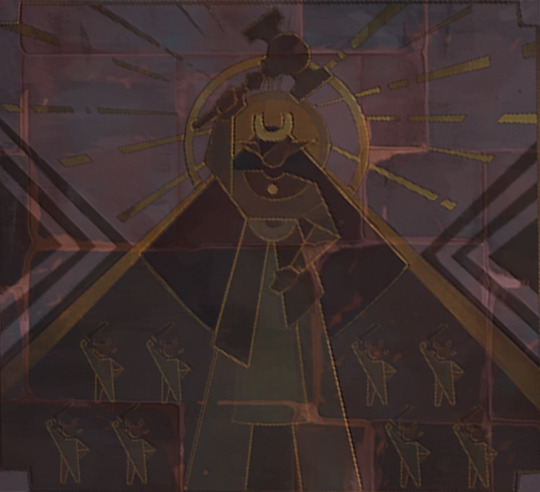
Who appears to even send her people into battle:

This could just be figurative, in that she's sending forth Sunfire elf warriors through equipping them with the best and most powerful weapons. It's also very unclear who the enemy they are fighting actually is—the blocky, hooded figures contrast with the horned elves in a way that suggests they might be humans, possibly including dark mages?
Possibly confusing the timeline even more, the clearest reference to the Forgemaster as an actual person is the Signet of the Forgemaster item and its text:
All of Lux Aurea knew that armor bearing her mark would be as strong as her will.
From this, we know that the Forgemaster lived at a time contemporary with Lux Aurea—which doesn't actually tell us a huge amount, given that Elarion stood for a thousand years or more and Lux Aurea is no doubt even older. Did she leave Lux Aurea to establish Blacksteel Sanctum? Was this before the Sunforge, or maybe before the Sunforge was an actual forge-forge? If magical smithing was unknown to the Sunfire elves before Blacksteel Sanctum, presumably the Sunforge either didn't yet exist or was used for other purposes.
The problem is mostly that we don't have any real concept of what "ancient" means to elves. If we the Blacksteel Sanctum murals depict dark mages, that would mean that it can't have been buried more than 1,000 years, unless we're going to reject the conventional understanding of when dark magic entered the picture. Is 1,000 years ago considered "ancient" for elves? I wouldn't expect it to be, but realistically we just don't know.
(That being said, for Blacksteel Sanctum to have been founded shortly after the continent was split for the expulsion of humans would explain things like the discovery of a buried source of primal magic, unearthed by the massive geologic shift. The part I can't wrap my head around is the idea that the Sunfire elves didn't discover magical smithing until the same time that humans were being given dark magic... but I could get used to the idea.)
Anyway, in addition to this mysterious figure of the past, there's also, y'know... this Forgemaster:
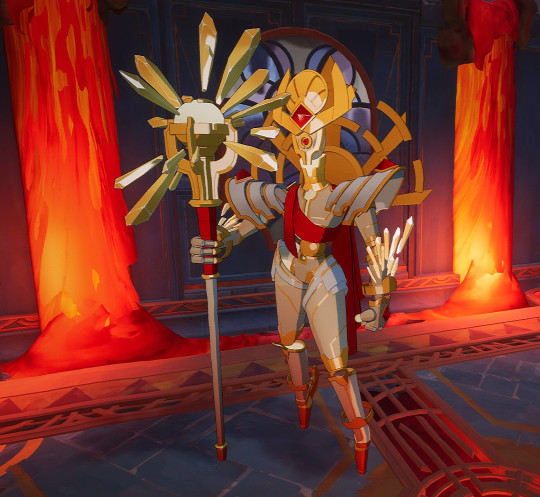
I.e., the "Blacksteel Forgemaster" golem, the first region boss encounter for the Border.
Story-wise, the Forgemaster golem is first referenced in an encounter with a Dawnbringer group that it exterminated, where the dying captain speaks of a "gleaming giant" defending the lower reaches of the Sanctum from exploration. Ravna confirms this account, and declares that the golem must be eliminated for further investigation of the Sanctum. Even at this point, it's not exactly a secret that there's a connection between this golem and the Sanctum's master smith:

This is made even more explicit after defeating the golem, when Ravna reveals that she went to inspect its remains, and it reactivated at her touch to deliver a message:




Now, Ravna seems to think that this was essentially a pre-recorded message stored in the golem, which is otherwise autonomous, but mindless. However, having played a video game or two with very similar plotlines... even if it's not where things start out, someone always eventually starts stuffing souls into these things. Personally, I have no doubt that this was the Forgemaster herself, or whatever shreds of her remained. This is also the first place we get an explicit reference to the Sanctum's downfall—that the Forgemaster herself went too far, and that horrible act, whatever it was, led to the Sanctum being abandoned.
Ravna is sympathetic to the Forgemaster golem's plea to let the Sanctum's secrets remain buried, and decides that once the scattered remnants of the Dawnbringers are cleared out, all exploration will end. She intends to return her full attention to the mission that really matters: securing the Border crossings and the shared future of humans and elves.
This is a fairly typical "act one" soft ending for a video game plotline that will be picked up again later—I very much doubt that it was intended to be the final, decisive ending of the story of Blacksteel Sanctum. My bet would be that the eventual TDP: Xadia roadmap would have included additional story arcs for each region, with new bosses and some new missions, maybe another mission map... something like that. These would be either a new story, probably sharing some of the same characters, or a continuation of the first "resolved" story from that region. For example, I would expect the Far Reaches to have a second act not centered around the Natamus, since that plot was pretty well wrapped up (though it could be opened again), but possibly following up on Zeph's mysterious backstory and departure at the end of the first arc.
For the Border and Blacksteel Sanctum, an obvious hook for act two would be for the Sanctum's true secrets, their awakening set in motion by the Dawnbringers, to finally started crawling up to the surface. Because I don't think the Forgemaster's golem was there only to keep intruders out... there's something down there that she was also intended to keep in.
Shadow and Flame: The Sanctum's Fall
(Oh, did you somehow think you were getting out of this without a Khazad-dûm reference? You were wrong.)
So the Forgemaster golem confesses to Ravna that she and her smiths did "something unforgivable," spurred by their own arrogance in considering themselves all-powerful, and their continued hunger for more knowledge and power in spite of that. However, there have also already been hints of a dark secret to the Sanctum, probably related to its decline and/or fall.
One is made nice and obvious in the form of the Sins of the Sanctum item, presented as a book and providing a one-line excerpt:
"... its moral heart did die and rot, but oh! Its fire and flames did not..."
Another, a bit more subtle, is the region armor set shared by Soren and Viren, which offers three ominous lines:
Something echoes in the metal. Does it sing, or does it scream? What did they bury down there beneath the earth?
Finally, and most importantly, there's what I'm just going to refer to as the "dragon forge." At the end of a story-oriented mission to escort Ravna herself while she explores the Sanctum, she calls out the final room in a pretty suspicious way:

Ravna links the Sanctum's most prominent forge with dragons, while Sins of the Sanctum links dragons, or a dragon, with the Sanctum's fall. There's also the reference in her original summary of the Sanctum's legends that one possible reason for its disappearance is that it was "destroyed by jealous dragons."
The draconic theme isn't the forge's only unusual feature, either:

It's worth noting that she delivers the line about its size immediately after you've defeated a giant mission-boss golem, so she's familiar with just how big those golems get. Based on the size and power of that golem, she also comments that her ancestors "clearly wanted this particular forge protected." We're meant to understand that whatever was made in this giant, dragon-themed forge was somehow special, and likely tied to the Sanctum's most prominent works... including the one that led to its downfall.
This is the room in question, by the way, or close enough to it:
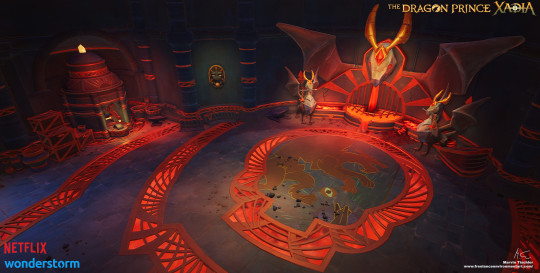
I'm not sure whether the stuff around the very perimeter is the same as in the game, but the dragon-themed forge itself and the floor pattern are accurate.
Ravna doesn't comment on the floor pattern, but I'm going to, because that center floor image is the main section of another mural that appears repeatedly throughout the Sanctum environment. It's on walls, banners, and floors, basically anywhere that a space needs to be filled. (The Forgemaster murals appear far more rarely, really only in specific areas.) With screenshots being both difficult to frame and not the best resolution, this non-game render is the clearest image of it:

It's easy to look at this and say "well, obviously that's the confrontation between Ziard and Sol Regem," except... it's not. Or if it is, it's not a depiction that makes any sense at all. Because look, if Sunfire elves know how to represent one thing in their decorative and architectural motifs... well, okay, back up for a second. If Sunfire elves know how to represent one thing, it's the sun. However, if they know how to represent two things, those are the sun and Sol Regem's horns. So unless everyone down in the Sanctum somehow forgot what Sol Regem looks like, that's not Sol Regem.
(There are actually no visual references to Sol Regem's horns in the entirety of Blacksteel Sanctum, aside from statues of juvenile dragons with only two horns in the same shape. Considering just how many there are in all other Sunfire architecture we've seen? That's weird. Like weird to the point that I wonder if it indicates some kind of schism between the Sanctum and Lux Aurea specifically about dragons.)
Additionally, the mural shows a massive, jagged hole in the dragon's chest, which is not something that happened to Sol Regem in the confrontation with Ziard. It's not 100% certain, but it seems to me that it makes more sense to interpret the central orb as being ripped from it, rather than being thrown at it. This is the imagery that is centrally and visibly featured in the dragon forge.
So we have 1) some terrible act by the Forgemaster, 2) the Sanctum's most prominent and unique forge being dragon-themed, 3) depictions of a dragon rent asunder, and 4) references to something buried in the depths, with fire and flame persisting beyond mortality.
Just to seal the deal, we also, if you do the kind of extensive ArtStation dive that I did, have this piece of concept art:
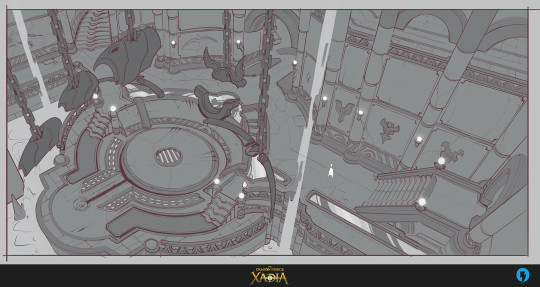
As Ravna says, the dragon forge goes "beyond armor and weapons for elves," and in this concept we have what appears to be pieces of armor for a dragon. Obviously it would be a pointless exercise to arm a dragon with forged weaponry, but could they have tried to armor one? What would be so unforgivable about dragon armor?
But wait, what did Ravna herself mistake for armor, when first entering the Sanctum? That's right.
They built a goddamn dragon golem.
Furthermore, as with the Forgemaster golem, they definitely put some piece of an actual, living dragon into it. Whether that was its heart, or its spirit, or something else, it was torn out and caged in metal. This could have been a malicious attempt by the Forgemaster and her smiths to enslave a dragon into their own control, or it could have been an altruistic attempt to save the life of one that had been torn apart by something else (dark mages?) by playing god. Either way, it seems that it went... quite badly. Badly enough that the Forgemaster not only had the Sanctum sealed and abandoned, but also put herself into a golem the same way, so she could stand as an eternal guard against her creation ever escaping or being freed.
Unfortunately, I would bet money that the dragon golem has already been awakened (probably by the magma crawlers). Remember the question of how the Dawnbringers knew about the golems? Well, as Saranar lies dying, the golems having proved to be uncontrollable and turned on her, she says this:

Someone a) knew about Blacksteel Sanctum, a place Ravna wasn't certain was even real, b) knew about the golems still remaining there, something Ravna had never so much as heard legends about, and c) promised the Dawnbringers power and victory, should they breach the Sanctum and take the golems for themselves. This could be the plot of an unusually well-informed external actor manipulating the local gang as cannon fodder to access some heavily-guarded secret, except they already ran that exact plot in the Far Reaches with Vant and Margot over the Natamus. I think it's more likely that the dragon golem has found a way of communicating with the outside world, and brought the Dawnbringers to the Sanctum knowing that they wouldn't stop digging for more power and weapons until they inevitably went too far and unearthed it. With the Forgemaster golem defeated, the last true line of defense for either direction—into the Sanctum or out of it—is now gone. Like I said, it's an excellent set-up for a second act.
I mean, as the Dragonbreath Embers item puts it:
Go on. Let them out. Surely nothing bad will happen.
So yeah! We'll also probably never find out if any of this is correct, since even if the game never re-launches or continues, anyone who could tell us anything is almost definitely legally prohibited from doing so... but we may have been robbed of an eventual epic boss battle with a golem dragon, among the countless other things that were in TDP: Xadia's future. THANKS, NETFLIX.
—
Speaking of people under NDA, here are the TDP: Xadia artists whose public portfolios were invaluable to researching and making this post:
Marvin Tischler
Alice Cho
Jacinta Vu
Guillaume T. Delbarre
Margaret Dost
Nelson Dou
Rebecca Blessing
Sara Lansdell
#anyway NOT ME thinking about soul entrapment/transfer being almost exclusively a dark/deep magic thing#and sauron in the guise of annatar bringing the secrets of magical smithing to celebrimbor to forge the rings#the dragon prince#xadia game#tdp: xadia#sunfire elves#kradogsmeta
53 notes
·
View notes
Text
The Dragon Hunters
First, to cover everything we learned of the Hunters excluding Johann's involvement:
The Hunters have been around for "generations" which according to wiki is 20 - 30 years per generation, making the hunters at least 40 years old, likely older. We know this because Ingar Ingerman's techniques have been used by Hunters for "generations".
(The fact that Fishlegs is unaware of Ingar's existence implies that he was either ancient, and "generations" refers to great-great grandparents or older, or that Fishleg's family broke away and purposefully forgot/didn't teach/lied to their children of their true family origin)
This age of the Hunters was also implied by Viggo, whose grandfather is mentioned as being either Hunter or Hunter adjacent many times in the series. Him playing as the Marauder and not the Viking Chief in Maces and Talons also suggests that he was a Hunter.
Making the age of the Dragon Hunters closer to 80 years. This is calculated using the average age for Httyd Vikings having children being 25 (Valka was 20, Stoick was 30 their average is 25, Hiccup and Astrid were both 25 when Zephyr was born) + Ryker and Viggo (the youngest known generation) being at least 30 or older.
This also makes Viggo a nepo baby/inheritor of the Hunter's legacy/throne/chiefdom etc rather than simply the best tactition there (this is of course, ignoring that Ryker is actually first in line as it seems that until RTTE he was happy for Viggo to take charge, possibly even waiving his claim for Viggo - or in a less happy circumstance, was forced to waive the chiefdom by his parents/grandfather).
as for the dragon eye:

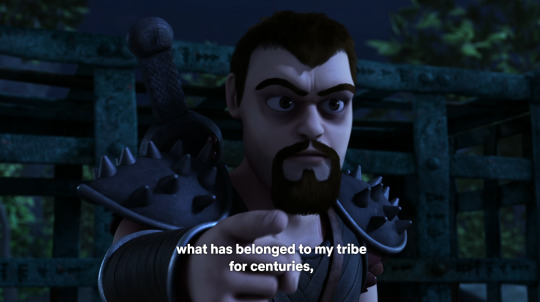
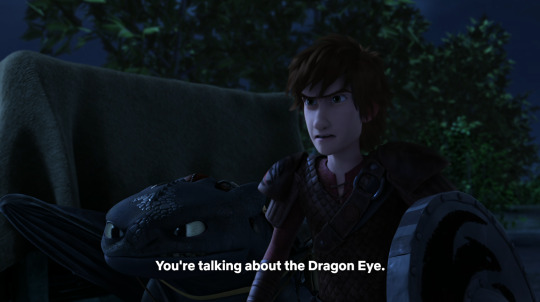
it's belonged to Viggo's tribe for centuries, and Viggo feels slighted by the loss of it. So we know that this is personal to Viggo's family/tribe regardless as to whether Viggo's tribe is the Dragon Hunters, is what became the Dragon Hunters, or if it was only the ancestors of a few Dragon Hunters (Ryker and Viggo).
This brings the possible age of the Hunters up to 200 - 300 years, as long as Berk has been settled/fighting Dragons. Or this is just their origin, when Viggo's clan settling in the region before becoming full blown Hunters.
we also know that Viggo knows the ins and outs of the Dragon Eye's construction, more so than even Ryker.
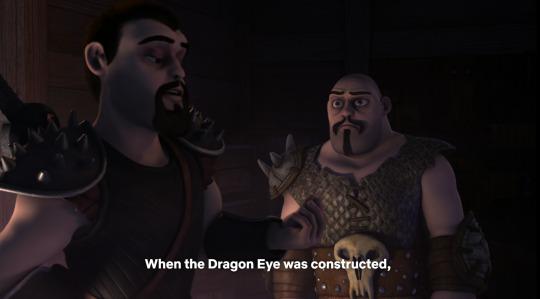
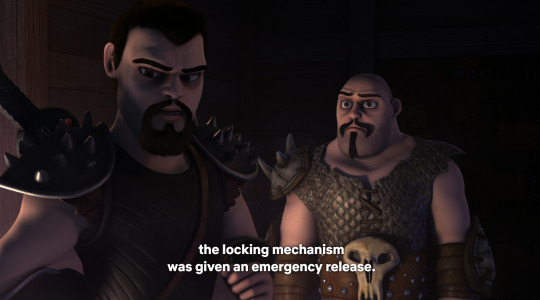
so it's possible that this information was passed down through the leadership of the Hunters, or more specifically, to the inheritor of Viggo's tribe's chiefdom. Both suggest that Viggo's grandfather may have been the one to impart this knowledge onto Viggo, as we also have the implication that Viggo inherited his intelligence (and love for Maces and Talons) from his grandfather.
The Dragon Eye going missing also seems to imply that the Hunters were felled/disbanded/forced into exile at some point, and Viggo and Ryker are only just now restoring them from the ground up - possibly in their grandfather's name. This is also where ym headcanon that Viggo at least used to live in/grew up in York/Jorvik comes from, as it would explain his english accent (ok, in the context of the show.. not real life as this accent wouldnt exist).
we also get a little insight into why the Hunters had this dark age/disbandment through Viggo's fall from power - the Grimborn's have no loyalty/regard for others and a short violent temper:
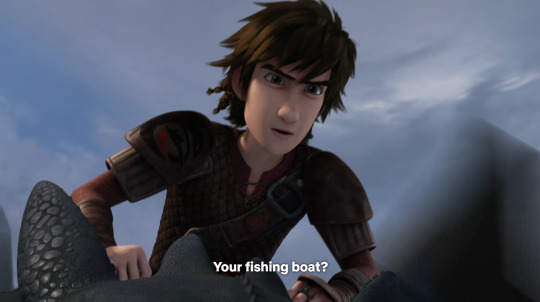

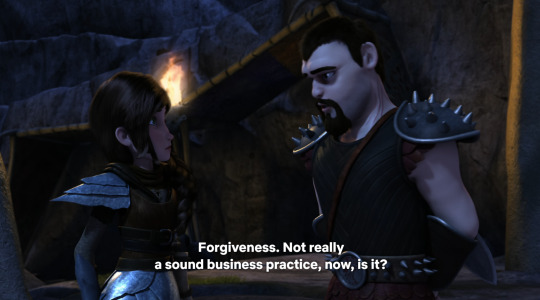
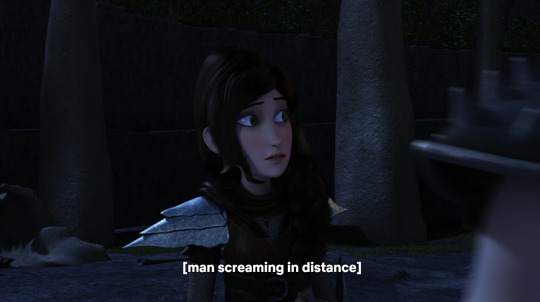
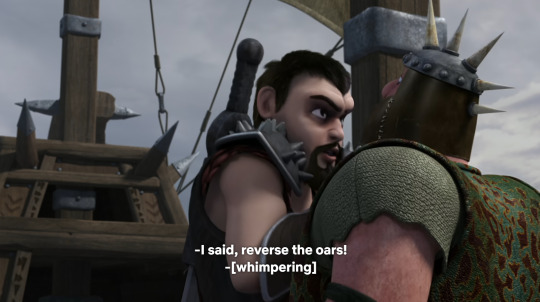
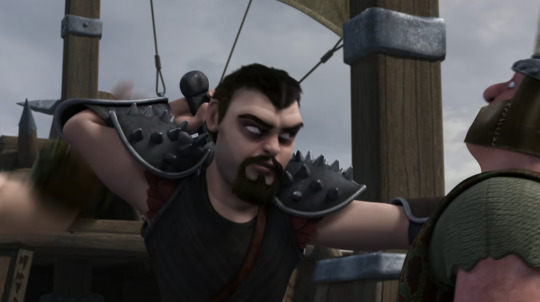


and viggo's focus on only his own pride
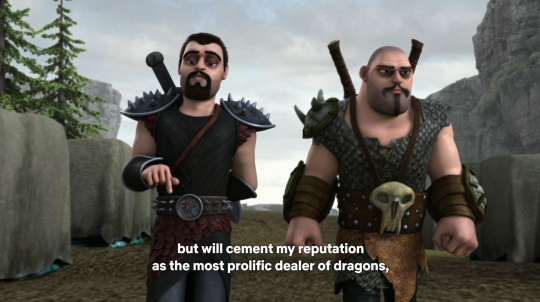
which is more than likely what killed them - the people rising up or abandoning them. which is technically what happened to Viggo, both through Ryker's betrayal, and the Hunters leaving him for dead.
Ryker's betrayal makes more sense when considering that he was the people's man.
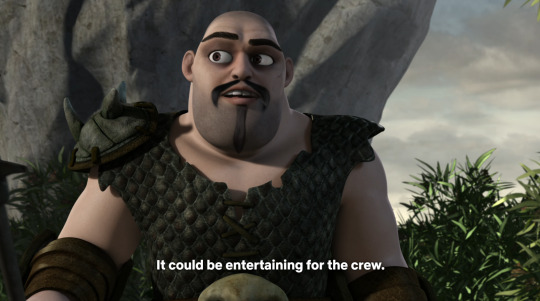
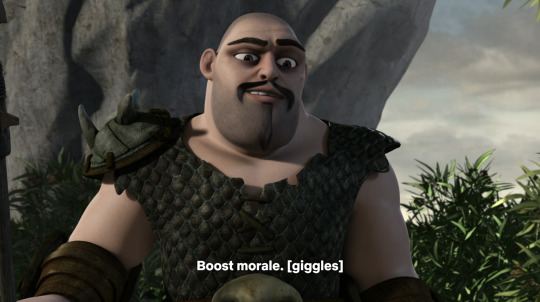
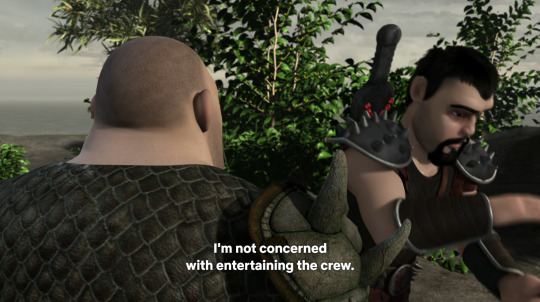
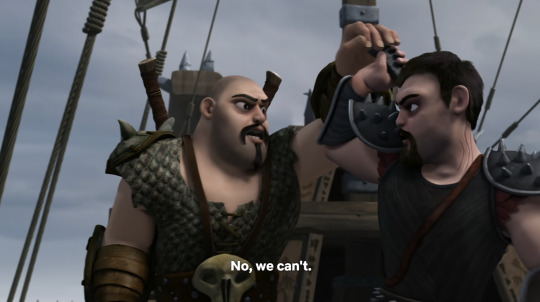
the Hunter's purpose, why they exist as a group, is to earn money. there is also additional themes of conquering the unconquerable, power and control, and genuine service to a people threatened by beasts.
The Hunters may have originally formed as a warrior group that worked as a sort of pest control, their methods for dragon killing are better and more refined than any other villain we see in the series, including the movies and grimmel as the movie villains seem more interested and successful in capturing and forcing dragons into a slave army than they ever are in killing anything.
the Hunters may then have begun using, or even spearheaded the use of dragon parts in clothing, materials, weapons etc. which might have earned them more money than pest control, leading to them using auctions and markets as their primary source of income.
their use of dragon root seems to be standard knowledge + practicality as Berk knows what dragon root is they just didn't refine it or use it in the same way.
their ships are confusing as they're mulltihull ships that are more in line with what Drago sails than what the vikings sail. this is confusing as Drago's ships are destinctive because he comes from elsewhere in the world and has travelled far to reach Berk. the Hunters ships seem to be stolen from Drago's fleet. perhaps suggesting a raid or battle, or even defection - but this doesnt fit with Krogan's arrival and their attitude towards their "buyer" (Drago).
To me the ships seem to be a bit of an oversight. an inconsistency that wasnt supposed to be thought about because they were just recycling assets (in the same way that Ryker is a recycled Drago design).
so s4 ends with the death of the Hunters in Shell Shocked: Viggo and Ryker are fighting each other and the majority of the Hunters have fled to Ryker's side (he is the people's man after all). Ryker is killed, viggo is injured presumed dead, the Hunters are all but destroyed (again)
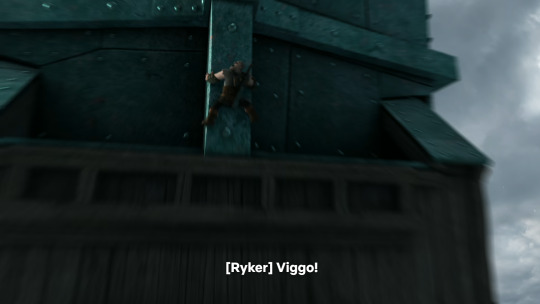
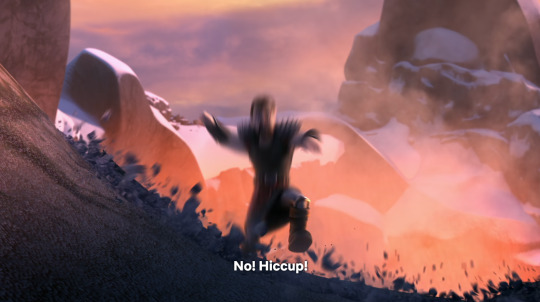
months go by and Krogan gathers up the remnants of the Hunters and forces them (penalty of death) to become his flyers.
Krogan's motivations are to bring success to Drago, in rtte's instance this seems to be through providing a Bewilderbeast for Drago.
Krogan seems to have thought that the Hunters are his best bet for finding a bewilderbeast, or gathering the resources to do it himself. He's known as a big buyer by Viggo and Ryker, so has only met them briefly if at all. He seems to have scoped out the Hunters in Auction Heroes and Midnight Scrum and decided that Viggo and Ryker are below him.
Krogan then apporaches Viggo and explains how he's usurped the Hunters and trained his flyers.
Krogan then offers Viggo the resources to recover the Dragon Eye from the volcano so that Viggo can keep ahold of his tribal artefact and potentially rebuild his empire, in return for his help in finding and capturing the King of Dragons/Bewilderbeast. Krogan gets access to Viggo's intelligence, and Viggo gets access to Krogan's resources.
Viggo's motivation seems to remain power, wealth and pride.
Viggo and Krogan crucially neglect to follow Ryker's example, they don't care for their men or armies, which ultimately leads to their downfall yet again:
Viggo obviously has his epiphany moment where his worldview is flipped and he learns to respect dragons, perhaps as a reflection on his relationship with his brother, and how his brother chose companionship and loyalty over wealth and power.
Krogan's armies are repeatedly defeated via their singetails not being loyal to the flyers.
Viggo dies as part of his redemption and Krogan is murdered for not realising his.
which explains the Hunters and everything we know about them excluding Johann. but now lets add Johann into the picture:
given all we know of the Hunters and the implications from Viggo that he inherited the leader position or revitalised it, it's unlikely that Johann was the "true" leader or secretly the leader of the Hunters. That position remains with Viggo and Ryker.
and we know that Krogan is both working for Drago and has usurped the Hunters through force. so Johann has no part in that either.
Johann himself says that he's paying them, so there's no loyalty to him outside of money.
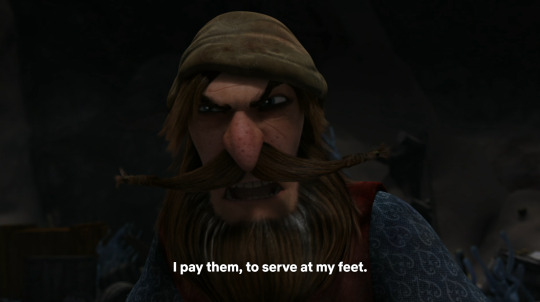
there's so many issues with Johann so let's just start with his statements in In Plain Sight
Johann reveals his motivation is to find the King of Dragons which he believes is the key to his wealth and power
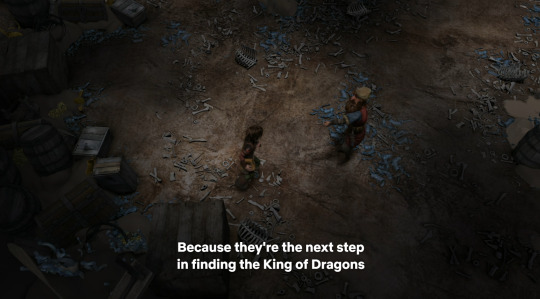
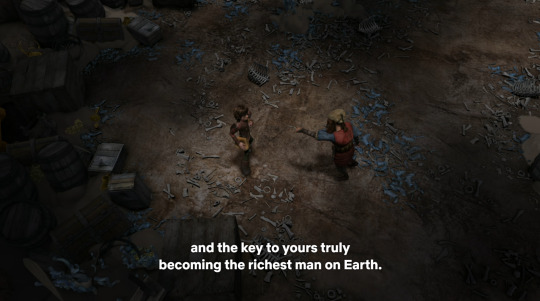
so all Johann wants is power and money, which he thinks the King of Dragons will get him. it's unclear if Johann plans to sell the bewilderbeast to Krogan (who gives it to Drago) or if he's oblivious to Krogan's motivations and just thinks he's there for the gold he's paying him.
I think it might be the latter because in King of Dragons Krogan betrays him twice, attempting to kill him. first by not warning him to dodge the bewilderbeasts ice, and then by stealing the egg and fleeing and leaving Johann to fight the bewilderbeast and hiccup and toothless alone.
Johann claims to have been working against the riders since Breakneck Bog
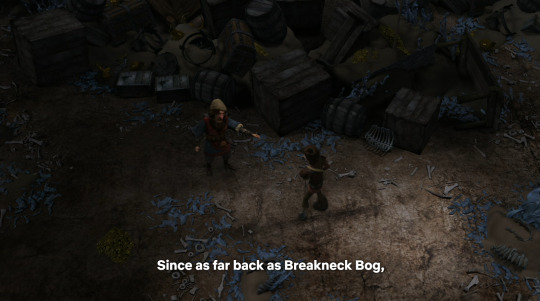
which happens in the first ever season, Riders of Berk, and is only Johann's second appearance, which I believe is an oversight from the writers as his first appearance 8 episodes prior had him sell poisonous flowers to Mildew who poisoned the dragons on Berk. was he not also behind that? that was actually much more villainous than Breakneck bog as he spent that episode begging them not to go there, stranded at sea, and then he loses all of his wares and gold.
this tirade against the Riders is more suspicous as his third appearance has him sneak the Berkians onto Outcast Island to rescue Hiccup.
his fourth has him stuck in a frozen sea, rescued by Hiccup and Toothless and then stranded on Berk with the speed stingers until the ice thaws.
his fifth has him sell smokebreath infested metal to Berk from Dagur. which, again, is more villainous that Breakneck Bog as it destroys Berk's armoury and comes directly from Dagur.
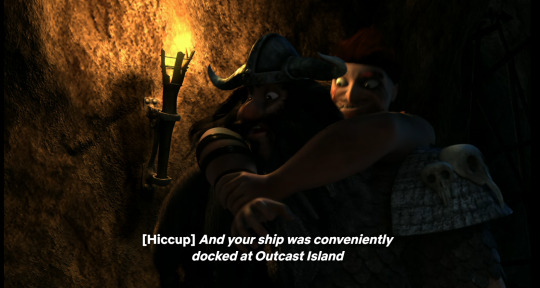
Johann also facilitated Dagur's escape, but, once again got stranded at sea. it makes you wonder just how good of a swimmer he is to have this much trust in his plans to incorporate getting stranded this many times.
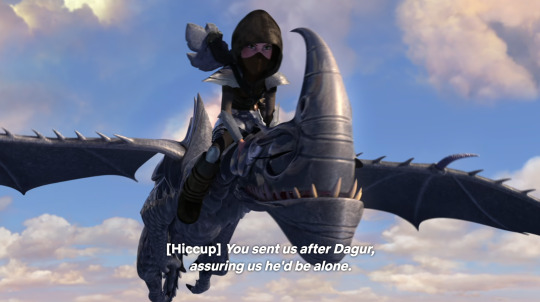
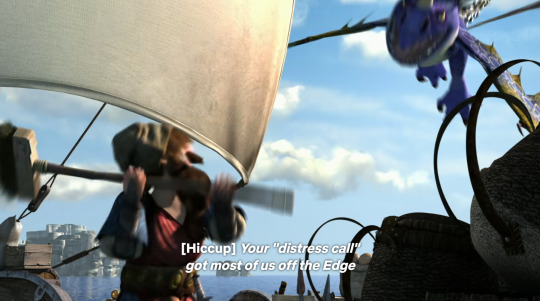
these two I have less complaints about in the "bad plan" department but they do cause some bumps with the "when did Johann ally the Hunters" question.
His speech to Hiccup, mentioning Breakneck Bog, suggests that he's been involved since Riders of Berk, when they were 15 - 16 yros. but his reaction to Viggo and Viggo's reaction to him in Last Auction Heroes is extremely weird if this is true:
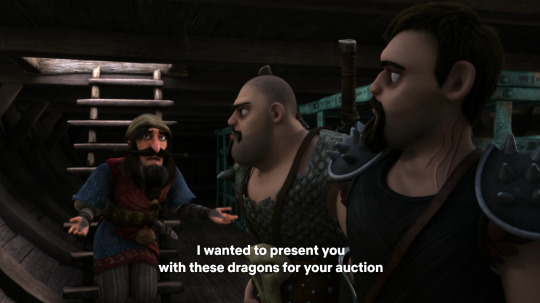
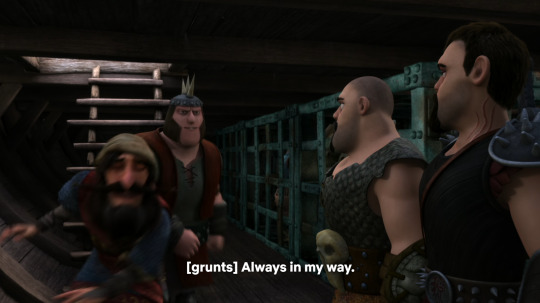
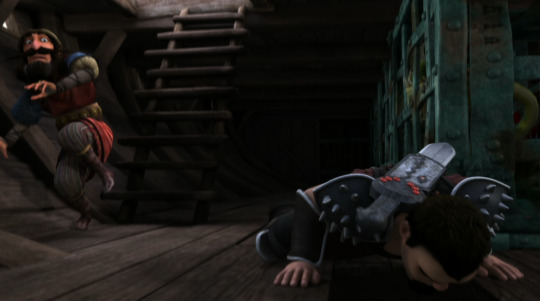
theres no need for any of these theatrics if they're in league with each other. if they are in league with each other here then Viggo should either be expecting Johann, and understand that the Riders are likely plotting something. or he should have some sort of communication with Johann that suggests they know each other, or that Johann can't talk freely else he'll blow his cover.
the way this scene in Auction Heroes plays out makes it seem as though Viggo has no idea who Johann is, and that Johann is still playing the long game by being deep undercover.
so when did Johann and Viggo actually join up?
I believe Dagur joined sometime around Have Dragon Will Travel as that's when he gets the dragon proof metal, which is associated with the Hunters alone.
Heather likely joined soon after.
but Johann doesn't seem to start acting suspicious or in league with the Hunters until s5, in Sandbusted. as his last appearance in s4 is Dire Straits, where he is the only survivor and near victim of the submarriper.
if he was in league with the Hunters at this point, why would he sail directly over the submapripper, planted specifically by the Hunters. if he was in league he could have just watched from a distance to check it was working, or have the Hunters themselves check.
Sandbusted has him send the Riders on a mission to find what's killing the merchants (sandbuster) which could easily be a trap set by him to separate the riders and get them killed off (hiccup specifically).
Dawn of Destruction has him separate Hiccup and Astrid from the Riders and the Edge immediately before the flyers attack. which also works perfectly fine for someone in league with them.
everything in s5 works towards the plot twist that Johann is secretly working with Viggo and Krogan. so it seems most likely that Johann joined between s4 and s5, after Ryker's death and the Hunters disbandment. He may even have paid Krogan to build the flyers and recruit Viggo to help him track down the King of Dragons.
He would need Krogan to bring skill and ruthlessness and to be a leader more interested in the results than the game. Viggo to bring his knowledge, experience and most importantly the Dragon Eye to track down the King of Dragons.
This would explain why Johann seems so out of the loop in Dire Straits and Auction Heroes, as he wouldn't have been allied or privy to the Hunter's plans. and he would still be undercover from Viggo and the Hunters as a whole.
His actions prior to this, such as Riders, Defenders, and Have Dragon Will Travel were likely his own plans, independent of anyone else's influence (and yes, i still think they're stupid plans as he ends up stranded at sea, losing massive swaths of his wealth which we have established is his entire motivation, and needed rescues from dragons a fucking lot).
the outlier here that I struggle to fit in is Edge of Disaster, as he pulls the Riders away from the Edge right as the Hunters attack. this happens in s2, long before he theoretically join in s5.
my best guess is that the Hunters, possibly with Dagur or Heather's help, were trying to use Johann as a distraction. Johann, being intelligent and hating the Riders might have seen this opportunity and "fallen" for the Hunter's trap/distraction - this might have involved the Hunters herding him towards the Dragon Nest.
However, this doesn't explain why Johann wouldn't blame the Hunters for forcing him into the Dragon's path, as it would take the blame/suspicion off of him for writing to Hiccup that he was under attack by the Hunters.
so to recap:
the Hunters likely evolved from Viggo and Ryker's clan, they may have stolen their multihull ship design from a section of Drago's army at some point. the Dragon Eye was created and their grandfather likely held a chief/leader position before the original Hunters were destroyed, likely because of the Grimborn's lack of loyalty to their crew and/or family. The Dragon Eye was lost and the Hunters disbanded, Viggo and Ryker ending up miles from home, possibly Jorvik.
Viggo and Ryker re-establish the Hunters, with Ryker giving Viggo the leadership role. They pick up allies in the Archipelago, Dagur most predominantly, followed by Heather, who recount to them that the Dragon Eye has been found and is being held by the Riders.
Viggo and Ryker then begin their war with the Riders, but Viggo falls into the same trap his ancestors did and forgets to value his crew or family. Ryker usurps the Hunters with the crew's support, but it ends in disaster and Ryker is killed, the Dragon Eye lost and Viggo injured.
Johann realises the potential of the Hunters now that they've disbanded and pays Krogan to recruit Viggo to use the Dragon Eye and rebuild the Hunters (under Krogan's command) to find and sell the King of Dragons.
or at least, that's the best that I can understand the Hunters?
126 notes
·
View notes
Text
My Life For Yours (Satoru Gojo x Reader Soulmate AU)
This is just the first part, planning on doing a part 2 and maybe 3.
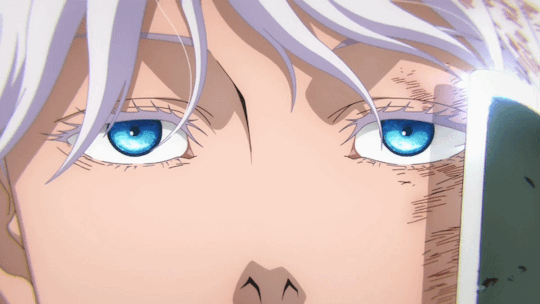
Satoru Gojo didn't believe you two were fated to be soulmates. Hell, he refused to believe it. How could he not? You were one of his fellow students in Jujutsu High, introduced to him by your friend Suguru Geto. You were considered a special grade sorcerer, but how was that when you were so weak? You couldn't fight, you could only support others, taking the blows for them with your cursed technique. With each blow thrown an ally's way, you used your technique to save them. The blow would always get blasted back to the enemy, but why would you harm yourself for that? Why go out of your way to protect someone you barely knew? He just couldn't wrap his head around it.
Maybe that's why he still can't wrap his head around what you did.
You found out he was going to fight Toji. You insisted you come along, he of course refused. You were too weak to help anyways. But you were a persistent one. You somehow convinced him to let you tag along as long as you didn't “get in the way”.
He wishes he didn't say that nor that he let you come along.
You hid while he and Toji were fighting, you didn't even let him know where you were. Maybe you were just waiting for that moment, the moment that was meant to kill him.
Toji would've killed him if not for you using your technique on him in a split second. The blow that was meant for him engulfed you, he swears you died on the spot then. But as you fell down, never to get up again, you smiled at him. Your voice rang through his head then. “Now, win this.” You died that day, Gods he wishes he didn't let you go. But with your death, his cursed energy soared. He easily defeated Toji after that, but he didn't feel satisfied. He kept sending blow after blow to Toji’s corpse till it was reduced to nothing. He went down to recover your body, seeing you still had that stupid smile spread across your face, with tear stains on your cheeks.
He was the one who brought you back to announce your death to Jujutsu High. “So… she finally did it…” Yaga told him. “She finally gave her life to someone else.”
He didn't understand what he meant. It was only later that he found that's why you were considered a special grade. You quite literally gave your power to him, making him stronger than before, giving him your life force. You were now a part of him.
He swears he sees you wherever he goes. You with that stupid fucking smile. He remembers screaming at your image, screaming that it was your fault he feels like this. And what did you do? You just smiled the whole time, albeit a bit sadder now.
He would visit your grave constantly, a grave that simply had your name plastered on it with the word “Oyasumi”. He hated that. He hated how you were reduced to just a piece of stone.
The last time he saw you was when he destroyed it. He couldn't control himself, his anger, his hate, his despair. He destroyed the only thing that was keeping you in this world. When the dust cleared, he saw you standing there, waving goodbye to him before walking away in the midst of the new morning.
“She's not coming back…” he heard someone say from behind him. He almost attacked that person too. They stopped him however, introducing themselves as ‘the prophet’. They gave you a choice. Kill them there and never be able to see you again, or attempt to change the past. Change the past? He remembers thinking. How stupid is this person? After hesitating to attack, the person came forward to him, offering him a bundle of forget-me-nots to him. He thought it was a sick joke. He was the only one to bring those flowers to your now decimated grave. He threw the flowers down, demanding the person explain why they were here.
“Simple, I just can't stand to see someone lose their soulmate.”
His…. Soulmate?
“She was yours, you know. And yet… you treated her like a mere pest. Yet she still gave her life to support you, to make you stronger than ever. Why?”
He was going to kill this person if they continued like that.
“I can give you a chance to re-do it all. To find her again, to make things right. After all, you love her, no?”
And so, here he was. Watching you from afar as you hung out with Suguru before you two were even supposed to meet. Now was his chance to make up for what he did. Now was the chance to give his life to you.
237 notes
·
View notes
Text
TWST Fanfics ideas - Classes exercices
I was wondering... what are the clases exactly? What do they learn in it? So here are my guess:
In the « normal » class (music, math, art….) the exercices listed here would be in addition of the « normal » exercices. Also I give a list of 10 potential exercices per class, but you can imagine others
~~~~~~~~
In a "Practical Magic" class they would focus on everyday magic for chores. The exercises could include: 1. Cleaning Charms: Students practice spells to clean objects or spaces without manual labor. 2. Cooking Spells: Learning to prepare meals with a wave of a wand, including chopping, stirring, and temperature control. 3. Repairing Enchantments: Casting spells to mend broken items, from clothing to furniture. 4. Gardening Magic: Using magic to tend to plants, making them grow faster or shaping them into artistic forms. 5. Laundry Spells: Enchanting clothes to wash, dry, and fold themselves. 6. Organization Charms: Spells that sort and organize personal belongings, books, or tools. 7. Protective Wards: Setting up magical barriers to keep homes clean and safe from pests or intruders. 8. Weatherproofing Spells: Enchantments to protect against weather, like waterproofing or temperature regulation. 9. Light Charms: Magical ways to illuminate spaces efficiently. 10. Summoning Spells: Conjuring objects to hand, saving time on searching for misplaced items.
~~~~~~
In a "Conjuration" class, the focus would be on summoning objects, creatures, or elements from thin air or from distant places. Here are some exercises: 1. Basic Summoning: Students learn to summon simple objects like feathers or stones to their hands. 2. Targeted Conjuration: Practicing conjuring items from specific locations, such as retrieving a book from a shelf. 3. Creature Summoning: Safely summoning small magical creatures and learning to interact with them. 4. Food Conjuration: Conjuring edible items, focusing on getting the taste and temperature right. 5. Elemental Conjuration: Bringing forth elements like water or fire, controlling their shape and intensity. 6. Conjuring Clothes: Instantly outfitting oneself with appropriate attire for different occasions. 7. Multiplication: Learning to duplicate objects, which is a complex form of conjuration. 8. Conjuring from Nature: Drawing materials directly from natural sources, like summoning water from a lake or leaves from a tree. 9. Advanced Conjuration: Summoning complex mechanisms or devices, understanding their assembly and function. 10. Emergency Conjuration: Quick conjuration drills for situations requiring immediate access to tools or aids.
~~~~~~
In a "Magical Potion" class, students would learn the delicate art of brewing magical concoctions with various effects. Here are some potential exercises: 1. Ingredient Identification: Recognizing and categorizing potion ingredients by their magical properties. 2. Mixing Methods: Mastering the techniques of stirring, shaking, and combining potion ingredients. 3. Temperature Control: Learning the precise temperatures needed for different stages of potion brewing. 4. Timing Practice: Developing a sense of timing for adding ingredients and the duration of brews. 5. Safety Protocols: Understanding the importance of safety when handling dangerous or volatile substances. 6. Potion Analysis: Testing and analyzing the effects of potions on inanimate objects or consenting magical creatures. 7. Remedy Brewing: Creating potions that heal ailments or counteract poisons. 8. Enhancement Elixirs: Concocting brews that temporarily enhance abilities or senses. 9. Transformation Potions: Experimenting with potions that can change one's appearance or species for a short time. 10. Invisibility Mixtures: Perfecting the tricky art of brewing potions that render the drinker invisible.
~~~~~~~
In an "Alchemy" class, the curriculum would likely explore the mystical side of transforming substances into new forms, Alchemy would also be a form of magical chemistry class. Here are some exercises: 1. Metal Transmutation: Practicing turning base metals into gold or silver, starting with small quantities. 2. Elixir Crafting: Brewing elixirs that promote longevity or enhance physical abilities. 3. Philosopher's Stone Theories: Studying the legendary Philosopher's Stone and attempting to replicate its properties. 4. Substance Purification : Learning to purify and refine substances to increase their magical potency. 5. Gemstone Synthesis: Creating precious gemstones from common minerals through alchemical processes. 6. Liquid to Solid Transmutation: Transforming liquids into solid forms, such as water into crystal. 7. Herbal Alchemy: Using plants and herbs to create powerful extracts and essences. 8. Magical Ink and Paper Making: Producing materials that can hold enchantments or spells. 9. Alchemical Symbols: Understanding and using runes to enhance alchemical reactions. 10. Advanced Alchemy: Attempting more complex transmutations and understanding the ethical implications of alchemy.
~~~~~~~
In a “Digital Engineering” class, students would likely explore the intersection of magic and technology. Here are some exercises:
1. Magical Circuit Design: Learning to create circuits that are powered by magical energy. 2. Enchanted Programming: Writing code that interacts with magical objects or creatures. 3. Rune-Based Computing: Using ancient runes to perform computations and process magical data. 4. Golem Programming: Crafting and programming magical automatons for various tasks. 5. Magical Interface Development: Designing interfaces that allow wizards to interact with digital devices. 6. Virtual Spell Simulation: Using virtual reality to practice spells in a controlled digital environment. 7. Enchanted Object Fabrication: 3D printing objects with embedded magical properties. 8. Magical Network Security: Protecting magical databases and networks from unauthorized access or curses. 9. Spellware Development: Creating software that enhances or channels magical abilities. 10. Technomancy Projects: Integrating technology and magic to create innovative solutions to common magical problems.
~~~~~~~~~~
In a “Magic Analysis” class, students would delve into the theoretical aspects of magic and its practical implications, to understand them and maybe creating your own. Here are some exercises:
1. Spell Structure Decomposition: Breaking down spells into their basic components to understand how they work. 2. Magical Flow Charting: Mapping out the flow of magical energy in spells and enchantments. 3. Ritual Analysis: Studying the steps of magical rituals to determine their purpose and effectiveness. 4. Magical Artifact Examination: Investigating the history and magical properties of various artifacts. 5. Potion Formula Deconstruction: Analyzing potion recipes to understand the chemical and magical reactions involved. 6. Enchantment Efficiency Testing: Measuring the strength and duration of enchantments to optimize them. 7. Magical Language Syntax: Exploring the grammar and syntax of magical languages and their impact on spellcasting. 8. Magical Ethics Debate: Discussing the moral implications of different magical practices. 9. Historical Magic Research: Examining historical texts to understand the evolution of magical practices. 10. Magical Theory Papers: Writing and peer-reviewing academic papers on various topics in magical theory.
~~~~~~~~~~
In an “Ancient Curses” class, students would explore the history, creation, and counteraction of curses from ancient times. Here are some exercises that might be included:
1. Curse Identification: Learning to recognize different types of curses and their symptoms. 2. Historical Curse Study: Examining ancient texts and artifacts to understand the origins of famous curses. 3. Curse Crafting: Understanding the components and ethics of creating curses (theoretical exercises only, magic analysis basics needed). 4. Protection Amulets: Designing and creating amulets that protect against curses. 5. Counter-Curse Development: Practicing spells and rituals that can counteract or break curses. 6. Curse Simulation: Role-playing scenarios to understand the impact of curses and practice countermeasures. 7. Language of Cursing: Studying ancient languages and scripts that were traditionally used to cast curses. 8. Ethical Implications: Discussing the moral considerations and consequences of curse usage. 9. Curse Removal Techniques: Learning various methods to cleanse objects, places, or individuals of curses. 10. Field Research: Visiting historical sites believed to be cursed and conducting investigations.
~~~~~~~~~~
In a “Defense Magic” class, students would learn how to protect themselves and others from various magical threats. Here are some exercises:
Shield Spells: Casting protective barriers to deflect or absorb magical attacks.
Counter-Spells: Learning spells that can negate or reverse the effects of incoming spells.
Disarming Techniques: Practicing spells and maneuvers to disarm opponents without causing harm.
Magical First Aid: Applying spells and potions to treat injuries caused by magical means.
Dark Arts Defense: Understanding and defending against dark magic, including curses and hexes.
Stealth and Concealment: Using magic to hide one’s presence or escape detection.
Anti-Poison Spells: Identifying and neutralizing magical poisons and toxins.
Magical Combat: Engaging in controlled duels to practice defensive and offensive spells.
Mind Protection: Strengthening mental defenses against magical intrusion and manipulation.
Environmental Defense: Using magic to manipulate the surroundings for protection, such as creating barriers or camouflage.
~~~~~~
In a class dedicated to “Poison Making,” which would be a highly controlled and ethically sensitive subject, students might engage in the following theoretical exercises:
Toxicology Basics: Understanding the properties of various toxins and their effects on living organisms.
Antidote Formulation: Learning to create antidotes for common poisons.
Safe Handling Procedures: Training in the safe handling, storage, and disposal of toxic substances.
Poison Detection: Practicing spells and techniques to detect the presence of poison in food and drink.
Historical Poisons Study: Researching historical uses of poison and the evolution of toxicology.
Simulated Poison Brewing: Theoretical exercises in brewing poisons with harmless substitutes.
Ethical Debates: Discussing the moral implications of poison use and the responsibilities of a poison maker.
Magical Containment: Learning to magically contain and neutralize poisons to prevent accidents.
Field Identification: Recognizing poisonous plants and creatures in their natural habitats.
Legal Knowledge: Gaining an understanding of the legal restrictions and regulations surrounding poisons.
It’s important to note that such a class would emphasize the importance of using this knowledge for educational purposes only, with a strong focus on safety, ethics, and legal compliance.
~~~~~~~~
In a class focused on “Changes and Comparisons of Abbreviated Spells in Ancient and Modern Magic History,” students would likely explore the evolution of spellcasting techniques and the efficiency of spell abbreviations over time. Here are some exercises that could be part of this class:
Spell Evolution Timeline: Creating a timeline to visualize the changes in spellcasting from ancient to modern times.
Abbreviation Analysis: Comparing the original long-form spells with their modern abbreviated versions to understand the changes in language and technique.
Efficiency Studies: Measuring the effectiveness and speed of casting abbreviated spells versus their full-length counterparts.
Historical Context: Studying the historical events that led to the development of abbreviated spells.
Cultural Impact: Examining how different magical cultures influenced the abbreviation of spells.
Language Shifts: Exploring how changes in magical languages have affected spell abbreviations.
Spell Adaptation: Practicing the adaptation of ancient spells into modern abbreviated forms.
Magical Linguistics: Understanding the linguistic principles that govern the creation of effective spell abbreviations.
Ancient Scripts: Learning to read and interpret ancient magical scripts where original spells were recorded.
Modern Usage: Discussing the role of abbreviated spells in contemporary magical society and how they fit into everyday magical use.
~~~~~~~~~~~
The “History of Magic” class would be about exploring the origins and development of magical practices. Here’s how the class might be:
Ancient Civilizations: Studying the role of magic in ancient exctinct societies.
Magical Artifacts: Examining historical artifacts and their uses in various cultures.
Famous Magicians: Learning about prominent figures in magical history and their contributions.
Evolution of Spells: Tracing the development of spells from ancient incantations to modern-day practices.
Magical Creatures: Investigating the historical accounts of magical creatures and their interactions with humans.
Witch Trials: Analyzing the social and political factors behind witch trials and their impact on magical practices. (assuming there was witch trials at some point in their history, and a time where mages weren't common)
Renaissance Magic: Exploring the resurgence of magical interests during certain times.
Magical Literature: Reading and discussing key texts that have shaped magical theory and practice.
Modern Magic: Understanding the transition from traditional to contemporary magic in the context of technological advancements.
Field Trips: Visiting historical sites and museums to see firsthand the remnants of magical history.
~~~~~~~~~~
In “Animal Languages,” students would learn about the communication methods used by various magical and non-magical creatures. Here are some exercises that might be included:
Basic Animal Sounds: Starting with the sounds made by common creatures (like cats) and understanding their meanings.
Magical Linguistics: Studying the structure of animal languages and how they differ from human speech.
Non-Verbal Communication: Observing and interpreting body language and other non-verbal cues used by animals.
Spell-Assisted Communication: Using spells to facilitate understanding between humans and animals.
Creature Vocalization Practice: Mimicking creature sounds to communicate directly with them.
Field Studies: Conducting fieldwork to observe and interact with animals in their natural habitats.
Magical Translation: Learning spells or using magical devices that translate animal languages.
Historical Animal Speech: Researching ancient texts for references to legendary creatures and their languages.
Interspecies Diplomacy: Role-playing scenarios that require negotiation and communication with magical creatures.
Conservation Ethics: Discussing the importance of preserving magical creatures and their languages.
~~~~~~~~~
In “Astrology”, students would explore the celestial bodies from a scientific perspective while also delving into the mystical aspects that have influenced human culture. Here are some exercises that might be part of this class:
Stargazing Sessions: Using telescopes to observe planets, stars, and other celestial phenomena.
Celestial Navigation: Learning to navigate using the stars and understanding the historical importance of this skill.
Astrological Chart Creation: Drawing and interpreting astrological charts based on the positions of celestial bodies.
Mythology and Constellations: Studying the myths associated with constellations and their origins.
Planetary Influence: Discussing the believed influences of planets and stars on human behavior and events.
Astronomical Calculations: Performing calculations to predict celestial events like eclipses and planet transits.
Space-Time Magic: Exploring theoretical magic that could be influenced by astronomical phenomena.
Astrological Predictions: Practicing the art of making predictions based on astrological signs and movements.
Cosmic Spellwork: Investigating spells and rituals that draw power from celestial events.
Scientific Debates: Engaging in discussions about the intersection of astronomy, astrology, and magic.
~~~~~~~~~~
In “Biology” class, students would study the life processes and organisms. Here are some exercises:
Magical Microscopy: Using enchanted microscopes to observe the cellular structure of magical plants and creatures.
Potion Ingredients Study: Examining the biological properties of common potion ingredients.
Genetics: Learning about the hereditary traits of common and magical creatures.
Ecosystems: Studying the interactions between magical creatures and their environments.
Plant Cultivation: Growing and studying plants with or without magical properties in a controlled setting.
Creature Dissection: Dissecting magical or common creatures (ethically sourced) to understand their anatomy and/or magical organ functions.
Field Trips: Visiting various habitats to study magical and common creatures and plants in their natural settings.
Conservation Magic: Learning spells and techniques for the conservation and protection of species.
Disease Research: Investigating diseases that affect creatures and how to cure them.
Biological Spell Development: Creating spells that can influence biological processes in plants and animals.
~~~~~~~~~~
In “Physical Education” class, the focus would be on maintaining physical health and learning how to incorporate magic into enhancing physical abilities. Here are some exercises that might be included:
Magical Warm-Ups: Starting each class with stretches and light exercises enhanced by warming spells.
Enchanted Obstacle Courses: Navigating obstacle courses that change magically, requiring quick reflexes and agility.
Broomstick Aerobics: Engaging in flying exercises that improve balance and coordination while on a broomstick.
Strength Spells: Learning spells that temporarily increase strength for lifting or moving heavy objects.
Magical Sports: Playing magical versions of traditional sports.
Endurance Charms: Using charms to boost endurance during long-distance running or swimming.
Flexibility Enchantments: Applying enchantments that enhance flexibility and prevent injuries.
Dance Magic: Incorporating magical elements into dance routines for a fun and active workout.
Meditation and Focus: Using meditation techniques to improve concentration and mental stamina.
Magical First Aid: Learning basic first aid spells for treating minor sports injuries.
~~~~~~~~~~~~~~~~~~
In “Flying” class, students would learn the art of flying, whether it be on broomsticks, magical board, or through levitation spells. Here are some exercises that might be part of the curriculum:
Broomstick Basics: Learning how to mount, dismount, and handle a broomstick properly.
Levitation Spells: Practicing spells that allow one to float or fly without the aid of objects.
Flight Safety: Understanding the safety protocols for flying, including protective spells and charms.
Aerial Maneuvers: Mastering basic flying techniques such as turns, stops, and speed control.
Magical board Handling: If applicable, learning to control and fly on magical board.
Group Flights: Participating in synchronized flying exercises to build teamwork and coordination.
Altitude Adaptation: Acclimating to higher altitudes and learning how to adjust for air pressure changes.
Racing Techniques: Engaging in friendly races to improve agility and speed.
Emergency Landings: Practicing how to land safely in case of an emergency or spell failure.
Weather Spells: Using spells to navigate and adapt to different weather conditions while flying.
~~~~~~~~~~~~
In “Swimming” class, students would learn not only traditional swimming techniques but also how to incorporate magic into their aquatic activities. Here are some exercises:
Water Adaptation Spells: Casting spells that allow students to breathe underwater and withstand pressure changes.
Aquatic Mobility Charms: Learning charms to enhance swimming speed and agility in the water.
Merfolk Communication: Studying the language and customs of merfolk to interact with them during underwater excursions.
Underwater Navigation: Using magical means to navigate through murky or enchanted waters.
Magical Marine Life: Identifying and studying the behaviors of magical creatures that live in water.
Water Safety Enchantments: Applying protective enchantments to prevent drowning and other water-related accidents.
Diving Techniques: Practicing diving spells that allow for smooth entry into the water from great heights.
Temperature Control Charms: Learning to regulate body temperature to comfortably swim in cold waters.
Underwater Spellcasting: Mastering the art of casting spells while submerged and dealing with the resistance of water.
Rescue and Recovery Spells: Training in spells and procedures for rescuing others from aquatic dangers.
~~~~~~~~~~
In “Music” class, students would explore musical arts, with and without magic. Here are some exercises that might be included:
Instrumental Enchantment: Learning to play and enchant instruments so they can be played magically without physical touch.
Magical Music Theory: Studying the theory behind music and how it interacts with magical frequencies.
Enchanted Choir: Singing in a choir where voices are magically harmonized.
Rhythmic Spellcasting: Combining spellcasting with rhythm to enhance the potency of spells.
Musical Creature Communication: Using music to communicate with creatures that respond to magical melodies.
Historical Magical Composers: Learning about famous magical composers and their contributions to the musical world.
Sound Manipulation: Practicing spells that manipulate sound waves to create music or silence.
Magical Performance: Preparing and performing in magical concerts or recitals.
Music and Emotion: Exploring how music can influence emotions and states of mind magically.
Instrument Crafting: Building magical instruments with unique properties and sounds.
~~~~~~~~~~~
In “Art” class, students would likely explore various forms of creative expression, possibly incorporating magical elements into their artwork. Here are some exercises:
Enchanted Drawing: Practicing drawing techniques with enchanted pencils that bring sketches to life.
Potion Paints: Creating paints from magical potions that change color or have other unique properties.
Sculpting with Magic: Using transfiguration spells to sculpt materials like clay or stone without physical tools.
Illusionary Art: Crafting art that moves or changes, creating illusions that trick the eye.
Magical Photography: Taking and developing photographs that capture magical auras or movements.
Wearable Art: Designing clothing or jewelry with enchantments that alter their appearance.
Art History: Studying the works of famous magical artists and their impact on magical society.
Artistic Spellwork: Learning spells that enhance artistic abilities or inspire creativity.
Magical Murals: Painting murals with spells that make them interact with the environment.
Restoration Techniques: Using magic to restore and preserve ancient artworks and artifacts.
~~~~~~~~~~~~~
In “Mathematics” class... well students would likely explore both the theoretical and practical applications of math, but may use magic too. Here are some exercises other than the "common" ones:
Arithmancy: Studying the magical properties of numbers and their use in spell-crafting and divination.
Geometric Spell Patterns: Drawing geometric shapes that form the basis of complex spell structures.
Potion Measurements: Precisely measuring and calculating potion ingredients for perfect brews.
Magical Algebra: Solving equations that predict magical phenomena or outcomes.
Astronomical Calculations: Using mathematics to predict celestial alignments and their magical effects.
Transfiguration Geometry: Applying geometric principles to accurately transfigure objects into different shapes.
Probability and Chance: Calculating probabilities to predict the outcomes of magical experiments.
Magical Graph Theory: Mapping out the connections between magical nodes or ley lines.
Temporal Equations: Understanding the mathematical principles behind time-related spells.
Mathematical Proofs: Proving theorems that underpin magical laws and principles.
~~~~~~~~~~
In “Health” class that would be held twice a year by the nurse(s), students would likely focus on both physical and magical well-being. Here are some exercises:
Magical Nutrition: Learning about magical foods and their effects on health and magical abilities.
Body Enhancement Charms: Understanding the ethical use of charms that temporarily enhance physical abilities.
Magical Hygiene: Learning spells and practices for maintaining personal and environmental cleanliness.
Disease Awareness: Studying magical and non-magical diseases, their symptoms, and prevention methods.
First Aid Training: Gaining practical skills in magical and non-magical first aid techniques.
#disney twisted wonderland#twst#twst wonderland#disney twst#twisted wonderland#twisted wonderland classes#exercices
61 notes
·
View notes
Text

Good slide from my IPM (Integrated Pest Management) module for Master Gardeners.
TBH I should go back a few slides and grab some other captures that I didn't think of at the time. IPM, for those who are unfamiliar, is the strategy of combining various science-based techniques to handle pests and pest potential, rather than running to the pesticides every time.
Pesticides not only have the health and environmental detriments you're probably already aware of, but carry risks from a practical point of view as well. For example, say you apply a broad-spectrum pesticide to a plant. On that plant is the pest you're trying to get rid of (insect A), but also an insect (insect B) that is a predator for another potential pest insect (insect C). You kill both A and B, and suddenly experience a surge in insect C.
One thing in the IPM toolbox is the above-mentioned Plant Phenological Indicators. (Don't worry, I also just learned the word phenology.) "The effect of climate on seasonal biological events (plant flowering and insect development)." A thing we all already knew to exist; we just didn't have a technical word for it. Anyhow, if you know that roughly the same conditions, like the same number of days above a certain temperature so far that year, lead to one visible phenomenon, you can use that as an indicator of another event. So here, the blooming of forsythia (that fun yellow-flowering bush that is one of the earlier signs of spring in many places) aligns with "time to control the goddamn tent caterpillars". Rather than later in the year, when you're already on the back foot with a booming tent caterpillar population.
In fact, and I feel real doofy for not having realized this on my own but oh well, we do actually know the conditions and general timing for the emergence of various pest species, and thanks to the Extension Service, we can just fucken...look that up and know in advance, "Oh yeah, it's time to start checking for Harlequin bugs". Which is SO much better than just always reacting to pests once they've become a big enough problem to come to your attention. Like, how cool is this pest predictive calendar??
23 notes
·
View notes
Text
Moringa Farming: A Super Plant for Health, Agriculture, and Sustainability
The Moringa value chain in Kenya is a dynamic and growing sector that offers numerous opportunities for economic development and improved nutrition. Moringa, often referred to as the “drumstick tree” or “miracle tree,” is known for its nutritional value and wide-ranging health benefits. Every part of the moringa tree, from the moringa leaves, pods, seeds, and flowers can be harvested throughout…
#growing Moringa#growing Moringa from cuttings#Moringa cultivation#moringa farming#Moringa fertilization#Moringa harvest methods.#Moringa intercropping#Moringa nursery setup#Moringa oleifera#Moringa pest control#Moringa pruning techniques#Moringa seed germination#Moringa soil requirements#Moringa spacing guidelines#Moringa tree care#Moringa tree planting#Moringa watering needs#Moringa yield improvement#planting Moringa seeds#sustainable Moringa farming
0 notes